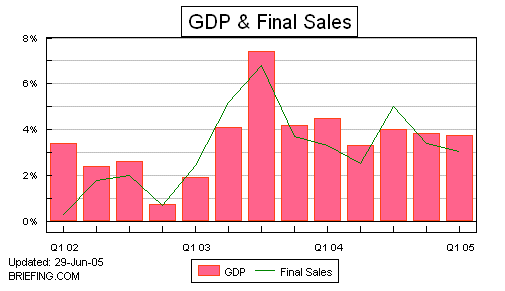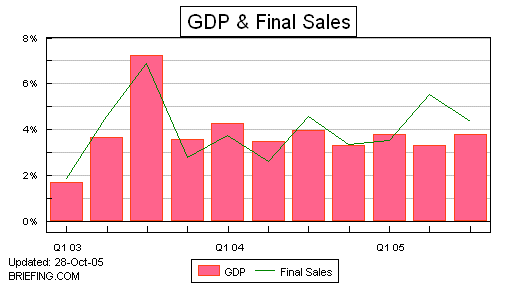GDP overstates ECONOMIC GROWTH
Again, it appears that the calculated GDP has overstated actual economic growth. June 29th's published GDP figure of 3.8%, is the same as the last quarter of 2004. However, growth of the 2/3's of economic activity due to consumer spending is slowing. The "final sales" growth, which many consider a better indicator of "growth," has declined for the 2nd straight quarter. In addition, growth of most "investment" parameters are also slowing.
The link to these numbers can be found at Briefing.com's GDP section at:
http://www.briefing.com/Silver/Calendars/EconomicReleases/gdp.htm
The 1st quarter GDP has now been revised upward to 3.8%. Again, this is the same as the 4th quarter of 2004. However, of the multiple factors used to compute this number, only 2 have increased significantly. The 1st of these is INVENTORIES, which increased from $47.2 billion in the 4th quarter of 2004 to $66.8 billion in the 1st quarter in 2005. This is a 42% increase over the previous quarter. The 2nd major increase was in "residential investment." (Housing & Real Estate) Here there was a 338% growth in the 1st quarter of 2005, from 3.4% in Q4, 2004 to 11.5% for Q1 of 2005.
In contrast to the above "increases," GDP final sales growth declined for the 2nd straight quarter. GDP final sales growth decreased to 3.0% from the 4th quarter's 3.4%. This marks a 13% DECREASE. The 4th quarter's GDP final sales also represented a decrease from the 3rd quarter's 5.0%. Thus, GDP final sales are not keeping up with the measured GDP. Ultimately, the GDP must be sold to create profits. The declining GDP "final sales" growth, in relation to the the total GDP, suggests the GDP is overestimating economic growth.
All other measures of consumer spending declined as well. Total personal consumption spending (PCE) growth decreased to 3.6% from the 4th quarter's 4.2%. All 3 components of PCE declined as well. Durable goods sales growth decreased 54%, declining from 3.9% in the 4th quarter to 1.9% for Q1 of 2005. Nondurable goods and services also decreased.
Nonresidential investment growth also decreased 72%, from 14.5% in Q4 of 2004, to 4.1% in the 1st quarter of 2005. Not only did growth in nonresidential investment not increase, it actually decreased in Q1 of 2005. The growth rate was actually -2.4%. Growth in equipment and software investment decreased from 18.4% in Q4, to 6.1% in Q1 of 2005.
Thus, GDP growth was maintained almost exclusively from increased real estate investment and increased unsold inventories. All indexes of consumer spending growth decreased. This comes as no surprise, considering inflation-adjusted wages also decreased during that time. Decreased consumer spending power usually decreases consumer spending.
It appears the calculated GDP has again overstated actual economic growth. Goods are being produced in excess of what consumers are purchasing. Excessive goods production drives down demand for labor to produce goods. This decreases the number of employed workers, as well as wages of those who are still employed. This results in a further decrease in the aggregate consumer income necessary to purchase goods.
Growth of inventories and real estate investment are all that have increased during the 1st quarter of 2005. Does this really represent economic "growth"? Doesn't declining growth in consumer spending imply an economic slowdown? Do isolated increases in unsold goods and real estate investment truly indicate economic growth? Can unsold goods and real estate investment really be substituted for consumer spending? Can profits lost from declining goods sales be replaced by production and investment increases? How does that increase profits? Doesn't someone have to buy products for profits to be made?
Update: 11/27/05
It now appears that the 3rd quarter 2004 GDP has been revised downward to 3.6 % which is what it was initially reported as like it in January of 2005. (By June 2005 it had been upwardly, and incorrectly, revised to 3.8%. Apparently they just "honestly" overestimated in June.)
Below are the graphs of the GDP previously reported, which were posted by "Briefing.com." The 1st is from January 2005, the 2nd is from June 2005, and the 3rd is from 11-27-05. Again, not the difference in the 4th quarter 2004 GDP. It has been revised back down to the previously reported 3.6% number.
1-28-05

6-29-05

11-27-05

Also of interest is that the 4th quarter GDP from 2003 has also been downwardly revised. Up through June of 2005, it had been listed as being over 4%. Now it has also been revised downward to 3.8%.
It's simply amazing how the Bush propagandists continue claiming a GDP growth rate of 4%. There hasn't been a quarterly GDP growth rate of 4% since the 3rd quarter of 2004, and only 2 since the 3rd quarter of 2003. Yet again the Bush-ites maintain that the economy is "strong, and getting stronger," with a GDP growth rate of "around 4%." We truly have a "faith-based" economy that depends on distortions and "faith" , not "facts."
EconomicPatriotForum

1 Comments:
This is a good post. I have a site about real estate book please look at it if you can.
Post a Comment
Subscribe to Post Comments [Atom]
<< Home